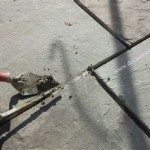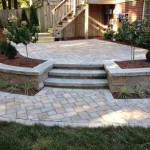How To Deep Clean Your Concrete Patio
A concrete patio provides a functional and aesthetically pleasing outdoor space, ideal for relaxation and entertaining. However, its porous nature makes it susceptible to accumulating dirt, grime, mildew, algae, and other unsightly stains. Regular cleaning helps maintain its appearance, but deep cleaning is essential for removing stubborn stains and restoring the concrete to its original condition. This article provides a comprehensive guide on how to deep clean a concrete patio, covering preparation, cleaning methods, and protective measures.
Before embarking on the deep cleaning process, it's crucial to understand the type of stains present on the patio. Different stains require different cleaning approaches and solutions. Oil stains, for example, necessitate degreasers, while mildew and algae require solutions with mildewcides or bleach. Identifying the type of staining allows for the selection of the most effective cleaning method, minimizing the risk of damage to the concrete.
Pre-Cleaning Preparation
Prior to the actual deep cleaning, thorough preparation is essential for optimal results. This involves several steps, including clearing the patio of furniture, sweeping away loose debris, and protecting surrounding areas from potential damage caused by cleaning solutions.
The first step is clearing the entire patio of all furniture, potted plants, rugs, and any other items that might obstruct the cleaning process. Remove everything from the area to provide unobstructed access to the entire concrete surface. This not only facilitates cleaning but also prevents damage to belongings from cleaning solutions.
Next, sweep the patio thoroughly with a stiff-bristled broom to remove loose dirt, leaves, twigs, and other debris. This step is critical as it prevents the surface debris from interfering with the cleaning solutions and potentially causing further staining or scratching during the cleaning process. A leaf blower can also be used if excessive loose debris is present.
Consider protecting surrounding areas, such as grass, flower beds, and siding, from potential splashes or runoff from the cleaning solutions. This can be accomplished by covering these areas with plastic sheeting or tarps. Secure the sheeting with tape or weights to prevent it from being displaced by wind or water. This precautionary measure minimizes the risk of damage to vegetation or discoloration of adjacent surfaces.
It is imperative to wear appropriate personal protective equipment (PPE) throughout the cleaning process. This includes wearing eye protection, such as safety glasses or goggles, to prevent splashes from irritating or damaging the eyes. Wearing gloves, preferably chemical-resistant gloves, protects the skin from contact with potentially harsh cleaning solutions. Finally, wearing closed-toe shoes prevents foot injuries from spills or dropped items and provides better traction on the potentially slippery wet surface.
Deep Cleaning Methods
Several methods can be employed for deep cleaning a concrete patio, each with its own advantages and disadvantages. The choice of method depends on the severity of the staining, the type of stain, and the available equipment.
Pressure washing is one of the most effective methods for deep cleaning concrete patios. A pressure washer uses a high-pressure stream of water to blast away dirt, grime, mildew, and other contaminants. Starting with a low-pressure setting is recommended to avoid damaging the concrete surface. Gradually increase the pressure until the stubborn stains begin to lift. Maintain a consistent distance between the nozzle and the concrete surface to ensure even cleaning. A fan nozzle is generally preferred over a concentrated nozzle, as it provides a wider cleaning path and reduces the risk of etching the concrete. After pressure washing, rinse the patio thoroughly with clean water to remove any remaining residue.
The effectiveness of pressure washing can be significantly enhanced by pre-treating the patio with a cleaning solution. Applying a concrete cleaner or degreaser before pressure washing helps to loosen stubborn stains and improve the overall cleaning results. Allow the cleaning solution to dwell on the surface for the recommended time, as indicated on the product label, before pressure washing. This dwell time allows the solution to penetrate the stains and break them down, making them easier to remove. Select a cleaning solution specifically formulated for concrete, and always follow the manufacturer's instructions carefully.
For patios with excessive algae or mildew growth, a solution of bleach and water can be effective. Mix one part bleach with three parts water in a spray bottle or pump sprayer. Apply the solution to the affected areas, ensuring the entire surface is thoroughly wetted. Allow the solution to dwell for approximately 15-20 minutes, then scrub the area with a stiff-bristled brush. Rinse the patio thoroughly with clean water to remove all traces of bleach. Exercise caution when using bleach, as it can damage plants and discolor some surfaces. Always wear appropriate PPE, including eye protection and gloves, when working with bleach. Avoid using bleach solutions on colored or stamped concrete, as it may cause fading.
For localized stains, such as oil or grease stains, a specialized concrete degreaser is often necessary. Apply the degreaser to the stain according to the manufacturer's instructions. Some degreasers require a dwell time before scrubbing, while others can be scrubbed immediately. Use a stiff-bristled brush to work the degreaser into the stain, agitating the area to loosen the contaminants. Rinse the area thoroughly with clean water. Repeat the application if necessary for stubborn stains.
In certain instances, a combination of cleaning methods might be required for optimal results. For example, pressure washing might be used to remove general dirt and grime, followed by a localized application of a degreaser for oil stains, and then a bleach solution for mildew. Assessing the specific stains and choosing the appropriate cleaning method for each ensures a thorough and effective cleaning process.
Protecting Your Cleaned Patio
After deep cleaning the concrete patio, applying a protective sealant is highly recommended. A sealant forms a barrier against water, oil, and other contaminants, making the patio easier to clean in the future and preventing future staining. Sealing also helps to prolong the life of the concrete by minimizing water penetration, which can lead to cracking and spalling during freeze-thaw cycles.
Before applying a sealant, ensure the patio is completely dry. Moisture can interfere with the sealant's adhesion and effectiveness. Allow the patio to dry for at least 24-48 hours after cleaning, depending on the weather conditions. Using a moisture meter can help determine if the concrete is sufficiently dry before applying the sealant.
Select a concrete sealant specifically designed for exterior use. There are two primary types of concrete sealants: penetrating sealants and film-forming sealants. Penetrating sealants soak into the concrete pores and provide invisible protection, while film-forming sealants create a visible coating on the surface. The choice between the two depends on the desired appearance and level of protection. Penetrating sealants are often preferred for their natural look, while film-forming sealants offer greater protection against stains and abrasion.
Apply the sealant according to the manufacturer's instructions. Most sealants can be applied with a roller, brush, or sprayer. Apply a thin, even coat of sealant, avoiding puddles or drips. Allow the sealant to dry completely before allowing foot traffic on the patio. The drying time will vary depending on the type of sealant and the environmental conditions.
To maintain the cleanliness and appearance of the concrete patio, regular maintenance is essential. Sweep the patio regularly to remove loose debris. Clean up spills immediately to prevent staining. Consider using a mild detergent and water to clean the patio periodically. Reapply the sealant every 1-3 years, or as recommended by the manufacturer, to maintain its protective properties. Regular maintenance will significantly reduce the need for frequent deep cleaning and prolong the life of the concrete patio.
By following these detailed steps, one can effectively deep clean a concrete patio, removing stubborn stains, restoring its original appearance, and protecting it from future damage. A well-maintained concrete patio provides a beautiful and functional outdoor space for years to come.

How To Clean Concrete Indoors And Outdoors

Diy Concrete Patio Cleaner Based On Science Chemistry Cachet

A Step By Guide To Deep Clean Your Concrete Patio

Pressure Washing A Concrete Patio Rolling Suds

How To Clean Paving Patios A Comprehensive Guide Awbs

How To Clean A Stained Patio The Ultimate Guide Checkatrade

How To Clean Concrete Floors With Pictures Wikihow

Best Way To Clean A Concrete Patio Chalking Up Success

How To Clean Concrete The Easy Way Porches Patios Driveways More Cleaning S House Tips

Diy Concrete Patio Cleaner Based On Science Chemistry Cachet
Related Posts








